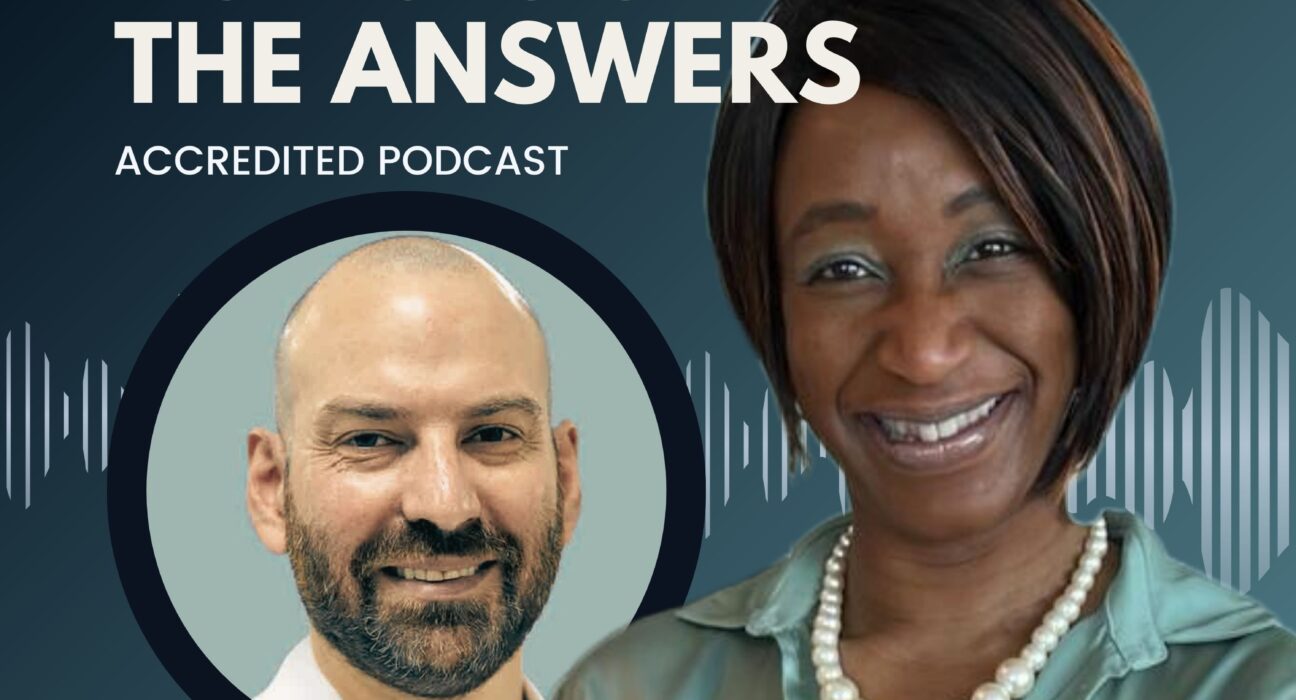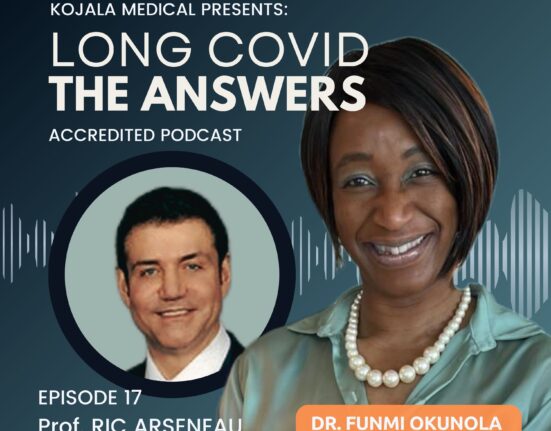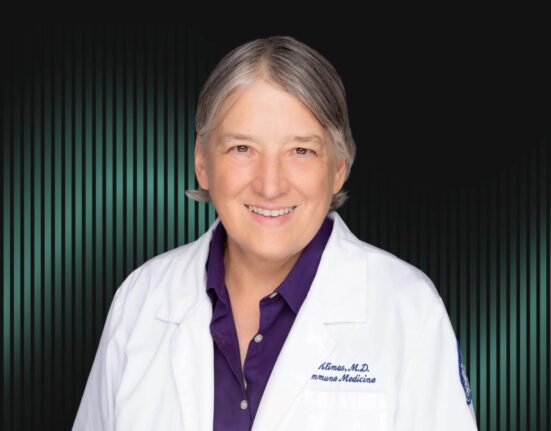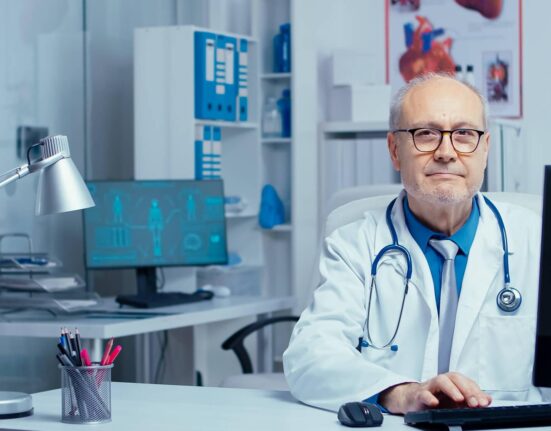
This podcast episode features Professor David Putrino, a physiotherapist and neuroscientist, discussing his research on potential treatments for long COVID. Putrino explores clinical trials repurposing HIV antivirals like Maraviroc and Truvada, targeting viral persistence and reactivated latent infections. His team employs a stepwise, experimental approach to identify responders and non-responders through deep phenotyping. This method aims to uncover biomarkers and refine treatments. Putrino also highlights the Cohen Center for Recovery from Complex Chronic Illness, a hybrid clinical and research center fostering collaboration among patients, clinicians, and researchers. The center focuses on accessible care, accepting insurance, and advancing solutions for long COVID.
Guest – Professor David Putrino
Note: The podcast has no bias. All conflicts of interest are highlighted with individual guests.
Healthcare Professionals | Earn 0.5 Certified Mainpro+® Credits! Please register/login to claim your CPD/ CEU credits.
Podcast Overview:
This episode continues the exploration of long COVID research, highlighting Professor David Putrino’s groundbreaking clinical trials. He discusses repurposed HIV antivirals, the importance of phenotyping, and the role of the new Cohen Center in advancing treatment and care for complex chronic illnesses.
Podcast Highlights:
- Clinical Trials for Long COVID: Focus on repurposed HIV antivirals (Trada, Moravo).
- Phenotyping Patients: Tailored approaches for responders and non-responders.
- Mechanisms of Potential Treatments: Exploring viral persistence and immune reactivation.
- Single vs. Multi-Drug Therapies: Stepwise progression in research strategies.
- Cohen Center for Recovery: A hybrid clinical-research model for accessible care.
DISCLAIMER: The information in this podcast is provided for informational purposes only. You should not use any information discussed in this podcast and related materials to make medical or healthcare related decisions. Always consult a your physician or other qualified health care provider with regards to diagnosing managing your medical condition. Any medications or treatments, including any discussed in this podcast, should be initiated and managed by a qualified health care professional.
Podcast Transcript:
Healthcare Professionals: Please note to claim Certified CPD / CEU credits toward your medical license (Canada & reciprocal CPD/CEU Worldwide), you will need to register or log in.
Episode 28 – Long COVID Research & Potential Treatments Part 2 ft Professor David Putrino
[00:00:00] Funmi Okunola: The information in this podcast is provided for informational purposes only. You should not use any information discussed in this podcast and related materials to make medical or healthcare related decisions. Always consult your physician or other qualified healthcare providers with regards to diagnosing and managing your medical condition. Any medications or treatments, including any discussed in this podcast.
Funmi Okunola: [00:00:00] Welcome to Long COVID – The Answers. Today’s Episode is the second part of a two-part series entitled “Long COVID Research and Potential Treatments”. In this Episode we’ll take a closer look at the clinical trials Professor David Putrino is conducting, focusing on some of the potential treatments for Long COVID.
I’d like to introduce Professor David Putrino. David is a physiotherapist with a PhD in neuroscience. He worked as a clinician in Australia before moving to the United States to study computational neuroscience at Harvard Medical School, the Massachusetts Institute of Technology, and New York University.
He has served as a faculty member at Weill Cornell Medicine and Burke Medical Research Institute. He is currently the Director of Rehabilitation Innovation for the Mount Sinai Health System, and a professor in the Department of Rehabilitation and Human Performance at the Icahn School of Medicine at Mount Sinai.
Professor Putrino recently opened the Mount Sinai Cohen Center for Recovery from [00:01:00] Complex Chronic Illness in New York, or CoRE, with Dr. Amy Proal, President of Polybio Research Foundation. Professor Putrino serves as CoRE’s Family Director and is also a member of Polybio’s Long COVID Research Consortium.
Welcome, David.
David Putrino: Thank you for having me. It’s great to be here.
Funmi Okunola: David, do you have any conflicts of interest to declare?
David Putrino: I have no conflicts of interest to declare.
Funmi Okunola: Great. We’re going to do a deep dive into the trials that Professor David Putrino is actually doing and why. Two of the drugs that you are clinically trialing as potential therapeutics for Long COVID are repurposed HIV antivirals. What caused you to look in this direction for treatments for Long COVID?
David Putrino: Yes. I would say we looked in this direction for two reasons. The huge body of literature that was talking about the potential for viral persistence in [00:02:00] Long COVID to be driving some of the symptoms, and then of course the work that we had done ourselves where we were showing that individuals with Long COVID were much more likely to have reactivated latent infections going on in their bodies. So, reactivation of Epstein Barr virus, reactivation of other herpes viruses.
As we were thinking about repurposing HIV drugs, some of the drugs that really caught our eye were Truvada and Maraviroc. Truvada, in early clinical trials showed some efficacy against SARS-CoV-2. Truvada is also a really powerful anti-EBV drug. It has the ability to attack EBV quite effectively and given the work that we did with Akiko Iwasaki’s group at Yale showing that EBV reactivation was one of the most prominent distinguishing features of Long COVID when we were [00:03:00] doing deep immune profiling on these patients, it seemed like a good idea to us to see if anyone was responding to Truvada.
Similarly, with Maraviroc, there has been some early evidence to suggest that Maraviroc might be effective in blocking the ability of the SARS-CoV-2 virus to enter cells. So, our theory there was even if we can’t eradicate SARS-CoV-2 maybe we can stop it from infecting cells in such a way that it’s maybe less able to replicate.
It’s less able to circulate in cells and cause all sorts of damage, and so was another drug that we wanted to trial. Again, due to the work that’s been done in the field of HIV it was certainly something that had a good safety record, and we felt confident that we could try it quite easily.
Funmi Okunola: The case study that inspired your research which [00:04:00] is detailed in a journal article called “Case Series, Maraviroc and Pravastatin as a Therapeutic Option to Treat Long COVID or Post Acute Sequelae of COVID”, published in ‘Frontiers in Medicine’ in February 2023, used Pravastatin with Maraviroc. Excuse my pronunciation.
David Putrino: No worries.
Funmi Okunola: A lot of the positive outcomes from this trial – alleviation of neurological, cardiovascular and respiratory symptoms, were achieved by using these drugs together. Why aren’t you using the combination of Maraviroc and Pravastatin?
David Putrino: Yes. We certainly were aware of Bruce Patterson’s work going into this, and in our opinion the mechanism of action that I was just describing earlier that Maraviroc may be able to successfully block the virus from entering the cells is the mechanism that we’re particularly interested in right now, although we believe that treating [00:05:00] Long COVID is going to be a multi-drug endeavor in our early phase one trials.
We’re really interested in this sort of experimental medicine approach of applying single molecules to patient populations, understanding what constitutes a responder and a non-responder, and then using that understanding to run larger clinical trials on single drugs where we have a much more strict and stringent inclusion criterion, and then moving into multi-drug trials where we can test multiple drugs at a time using more sophisticated clinical trial methodologies such as adaptive platform trials.
The case series that was published in ‘Frontiers’ was interesting, but it really did not provide too much insight in the way of predicting who would respond and who wouldn’t respond although we do understand the benefit of integrating statins [00:06:00] into an interventional protocol.
In part one of this episode, we were talking a little bit about endothelial damage and inflammation and so on and so forth, and how endotheliosis may play into the overall pathology of Long COVID. Well, one of the most effective ways to address endotheliosis is of course the use of statins.
From just a general treatment approach it really does make sense to do something like that. However, right now we’re trying to understand the mechanisms of single drugs – what they’re doing to people. We want to understand if someone responds really, really well to a single drug, why is that? What really was driving that improvement that we saw. That’s why we chose to do a single drug as opposed to a combination drug approach.
Funmi Okunola: Well, that’s clarified things for me. You’re doing a kind of a stepwise progression in your research. It’s really clear as to how the mechanisms are working here, and that will be a great [00:07:00] building block for the future. So, thank you.
Individuals with Long COVID experience more than 200 symptoms, and the different phenotypes or classification of Long Haulers are not well defined. How are you identifying the most suitable group of patients who are likely to benefit from the use of each of these drugs in your clinical trials?
David Putrino: It’s a great question, and it’s a challenging question. I’ll preface by saying all opinions are valid here. I’ll tell you what our approach is, and I’m not sure that it’s the right one, but it’s the one that we’ve selected, and I think the key phrase here is ‘experimental medicine’.
We’ve started our early clinical trials. We’re testing about seven or eight drugs or different interventions right now, and we’ve started our early trials with a broader approach to inclusion with every single person that is enrolled in the trial being deeply phenotyped, although [00:08:00] where we are casting a bit of a broad net in who we include and to that end really the only thing that we need for inclusion is a confirmed SARS-CoV-2 diagnosis, and a confirmed Long COVID diagnosis. But what we do is we deeply, deeply phenotype everybody.
We do a full immune panel including immune testing that can’t be purchased or done using traditional blood. We’re working with partners like Akiko Iwasaki. We’re doing very detailed neurological assessments, and we’re doing very detailed endothelial assessments and what have you so that when we do see responders, we can understand who responds.
When we see non-responders we can also see that a biomarker of interest doesn’t move because I think that understanding why something doesn’t work right now at this stage is just as important as understanding [00:09:00] why it does, because if you ask anyone who’s either researching in the Long COVID community or treating in the Long COVID community or just a member of the Long COVID community trying to get by, trying things out, they will tell you that some things work on some people like magic and for other people it does absolutely nothing.
I think possibly one of the most relevant examples of that would be low-dose naltrexone. You will hear a large swath of people saying, “I tried low dose naltrexone, and it did absolutely nothing for me,” and you’ll hear other people say, “It has turned my life around.”
What we need is deep phenotyping studies to understand why did the person who didn’t respond not respond? And why did the person who did respond, respond? Currently we’re not getting that. We’re getting clinical trials that just give a whole bunch of people the drug – “Oh, you got better,” and “You didn’t get better,” and we’ll just report [00:10:00] the statistics, or even worse, we see a case series coming out of clinics where maybe they’re treating thousands of people with the drug but only 100 or so get better, and they publish that case series of the 100 people who got better with no insight into why they got better, no insight into what was the difference between them and the 2,900 people who didn’t get better. What drove the response, and if we could really dig into that, I think we would start to better understand what’s happening in the community.
Funmi Okunola: So, from what you’ve just stated, am I understanding that you’re quite broad. You take people into the studies – at present you’ve got a positive test for SARS-CoV-2, but then as you progress through the study and see who responds and who doesn’t, you do all of these very detailed tests of their immune system and their endothelial system to parse out phenotypes in that way [00:11:00] rather than saying, “Oh, it looks like you might have MCAS and “it looks like you might have a clot” pre-study, and then separating them off beforehand. Am I correct in my understanding there?
David Putrino: That’s correct. The only thing I’ll say is slightly different is if we are testing a drug that, for instance, were we to test the monoclonal in a clinical trial we might slightly alter that approach.
We would still cast a broad net with regard to diagnosis, but what we might do is only include individuals who got sick in a certain time point because that intervention would likely only help people who had persistence as a result of an infection from January 2021 to March of 2022.
Now we would still at that point cast a wide net. We wouldn’t say, “Hey, we’re only going to recruit [00:12:00] people who have spike protein circulating around in their plasma.” Because still again I would really like to know if we see no evidence of viral persistence, do you not respond to the monoclonal?
Whereas if we see persistence in your gut, spike protein circulating around in your plasma, are you going to be a very strong responder to the protocol? And to be clear as we start getting more and more signals to understand who responds and who doesn’t, that’s when we’ll run the extremely restrictive clinical trial to better understand what’s going on because right now, from a pathobiology standpoint, there’s so many things happening. There are so many things going wrong that we could be totally wrong about who’s going to respond and who isn’t? And if we hedge our bets too much, we may end up getting no information as opposed to some really useful information that we might miss if we’re not being as [00:13:00] comprehensive with our assessments.
Funmi Okunola: Oh, it’s just fabulous. I’m listening to you. I’m really hopeful there’s not just going to be treatments but even a possible cure with your whole approach. It’s just so exciting and it just gives real, real hope. So lastly, can you talk about the new Cohen Center for Recovery from Complex Chronic Illness or CoRE at Mount Sinai and what you hope to achieve there?
David Putrino: Yes. Thanks to some really amazing donations from some incredible organizations such as the Stephen and Alexandra Cohen Foundation, the Nash Family Foundation, the PolyBio Research Foundation, who have helped with a lot of our research, and also donations from organizations funded by Vitalik Buterin, such as Balvi and Canro, we have been incredibly fortunate to be able to build this Center, brick by brick with our patients, and the Center [00:14:00] is designed as a Hybrid Research and Clinical Center. So, you can, of course, attend strictly for clinical care. You can attend to take part in research, but you don’t want clinical care, or you can attend, and you can do both.
But the reason that we set up Centers that are Hybrid Clinical and Research is so that the researchers are always talking to the clinicians, who are always talking to the patients, who are also always talking to the researchers, and we have this cross pollination and community co-design environment where if we see something is working, we can quickly scale it into clinical operations. The center is designed to take up insurance in the U.S. because we feel that there are too many cash only clinics that are popping up all over the place, and that’s just not sustainable for people with Long COVID who are very, very sick.
We work really hard to make sure that we take insurance as opposed to just charging straight cash from our [00:15:00] patients. In addition to that, we’re constantly writing down and upgrading our protocols so that we can educate others on what we’re doing. We have a saying at the Center that we keep repeating like a mantra, which is that if we become a destination clinic where people are coming from all over the world to see us, that means that we’ve failed in our mission.
Our mission is to be a Center that launches a thousand Centers – to be the Center that shows thousands of other groups who want to build their own Center how to do it, and how to do it in a way that is cost effective and accessible to the patient population that needs it so much.
So that’s a little sort of an insight into what we’re building, and it’s a learning process. We’ve made a lot of mistakes along the way. We’ve learned from them. We take feedback, and we try and just continually upgrade our Center to keep making it better and better for the patients.
Funmi Okunola: Oh, David, that’s [00:16:00] just so wonderful, and anything that we can do to help realize what you’re trying to achieve at CoRE, we’ll put our resources into facilitating. It’s just absolutely fantastic. We need to clone the whole lot of you for the world, really.
David Putrino: That would be really helpful for us as well.
Funmi Okunola: Thank you, David for taking the time to enlighten us today and to give all of us hope. Thanks to you, your team at Mount Sinai and all the scientists at PolyBio for providing hope and help to individuals around the world suffering with Complex Chronic Disease.
David Putrino: Thank you so much for having me helping to get the word out. We really appreciate the programming that you run, and it’s definitely helping spread education to a lot of people. Thank you.
Funmi Okunola: That was the last Episode in our present series of ‘Long Covid – The Answers,’ and I think a great way to end it. Thank you all for joining us in what has been a remarkable journey of discovery and [00:17:00] education for us all.
Funmi Okunola:
Some questions for listeners to consider.
What are your top five takeaways from this Episode?
How will this Episode change your practice or perception of this disease?
What will you do to act on what you’ve learned?
Please discuss your thoughts on our social media outlets such as Twitter or X, our website blog, Instagram, Facebook, LinkedIn.
Please rate this Episode.
SHOW NOTES:
Professor David Putrino is a physiotherapist with a PhD in Neuroscience. He is currently the Director of Rehabilitation Innovation for the Mount Sinai Health System, and a Professor in the Department of Rehabilitation and Human Performance at the Icahn School of Medicine at Mount Sinai. Professor Putrino recently opened the Mount Sinai Cohen Center for Recovery from Complex Chronic Illness in New York also known as (CoRE) and serves as CoRE’s Family Director and is also a member of PolyBio’s Long COVID Research Consortium.
Today’s episode is the second in a two part series looking at research into potential treatments for Long COVID.
REFERENCES
1 Polybio Article – A clinical trial of repurposed HIV antivirals in Long COVID
3 Polybio Article – Long COVID low-dose rapamycin clinical trial
4 Polybio Article – Lumbrokinase Long COVID & ME/CFS clinical trial








